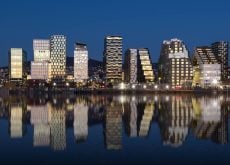Vietnam is a fascinating country, rich with culture and history. We also visited Cambodia and its renowned ancient temples, the most famous being Ankor Wat, a UNESCO world heritage site. This was my first time in Southeast Asia. The contrasts are ubiquitous, with modern vehicles sharing streets with rickshaws, modern skyscrapers neighbouring hovels, and elite worldwide brands in shops below frugal apartments.
Hailing from clean-aired Western Canada, I was initially taken aback by the smog level. On the first cab ride between the airport and the hotel, I kept wondering whether the air was filled with fog or smog, but given that fog lifts, a couple of days later I concluded it was largely smog.
Using Vietnam as an example, with this essay I hope to use observations from the streets combined with statistics readily available to better understand energy needs of a burgeoning developing economy. Since the turn of the millennium, Vietnam has been growing rapidly with an economy now 12 times larger than in 2000. A growing economy with increasing wealth drives energy demand.
Read Also

Health hazards are often overlooked risks on the farm
While quite different from the dangers posed by farm machinery, hazards such as loud noise or sun exposure require the same proactive attention, the Canadian Agricultural Safety Association says.
Ho Chi Minh City, formerly Saigon, is a southern city of 13 million people, eight million scooters/small motorbikes and one million automobiles. At street level the smell of exhaust from countless motorbikes permeates the air. The ratio of motorbikes to autos might at first glance represent a great opportunity for new car sales. However, it would be impossible for the road system to handle a huge influx of cars, and scooters can scoot when autos get stuck in traffic.
Energy consumption has grown sixfold since 2000. The fastest growing energy source is coal, up over 10-fold, representing 45 per cent of total energy consumed, and clearly a key source of the omnipresent smog. Both hydroelectricity and natural gas have quintupled, while oil has grown about three times. Renewables have emerged, representing seven per cent of the total energy mix, while nuclear is not yet part of the equation. The disconcerting stat is the dramatic growth of coal. (Source: Our World in Data.)
I was curious how Vietnam ranked for air quality and found a great website ranking most countries in the world. Indeed, Vietnam is 22nd-worst, with other populous countries, Bangladesh, Pakistan, India and China, even worse.
Carbon dioxide does not cause smog. Smog is caused by true pollutants such as nitrous oxide, sulfur dioxide and particulate matter. There are no health risks due to carbon dioxide, but significant ones with smog. While it is well known that natural gas produces about half the carbon dioxide as coal, I had difficulty finding references comparing smog production between the two fuels, which in itself is telling. I however found two references: firstly, “Analyses by the U.S. Department of Energy indicate that every 10,000 U.S. homes powered with natural gas instead of coal avoid the annual emissions of 1,900 tons of NOx, 3,900 tons of SO2, and 5,200 tons of particulates. Reductions in these emissions translate into public health benefits, as these pollutants have been linked to problems such as asthma, bronchitis, lung cancer, and heart disease for hundreds of thousands of people,” and secondly, the informative table you see on this page.
Vietnam is by no means unique in its use of motorbikes. Worldwide, there are almost as many bikes sold annually as automobiles, about 65 million versus 80 million. Electric vehicles do very little in reducing carbon dioxide because of the energy-intensive nature of battery production. They however have a redeeming quality in improving air quality in large urban centres. My lungs would have appreciated it if all those bikes were electric rather than gas. However, this benefit is contingent on the electric energy source being significantly less polluting than coal, like gas, nuclear or renewables.
While electric vehicles are somewhat impractical in cold environments, the vast majority of the world’s population resides in areas such as Vietnam, with moderate to hot temperatures.
From an investment perspective, I continue to see significant opportunities in all forms of energy, including renewables. While my initial investment in the world’s largest lithium producer, Albemarle, hasn’t performed well due to plummeting lithium prices, my street observations of a developing nation suggest a large need for battery power. My recent solar investment in Enphase Energy is similarly lagging. However, my long-term investment in uranium producer Cameco has been superb. I continue to believe these three companies are amongst the best in the alternative energy space.

I have long maintained the singular focus on carbon dioxide has taken our eye off real environmental issues where progress can be made. Garbage and smog would be two such issues. I would submit there is not only a business case for exporting liquefied natural gas (LNG), but an environmental and health imperative to do so. In yet another missed LNG opportunity, Vietnam recently announced a supply agreement with Qatar. Does their natural gas produce less carbon dioxide than ours?
My hope is to return to Vietnam at some point in the future, to enjoy its rich culture and history while breathing clean air with electric motorbikes and autos fueled by western Canadian natural gas and uranium.
















